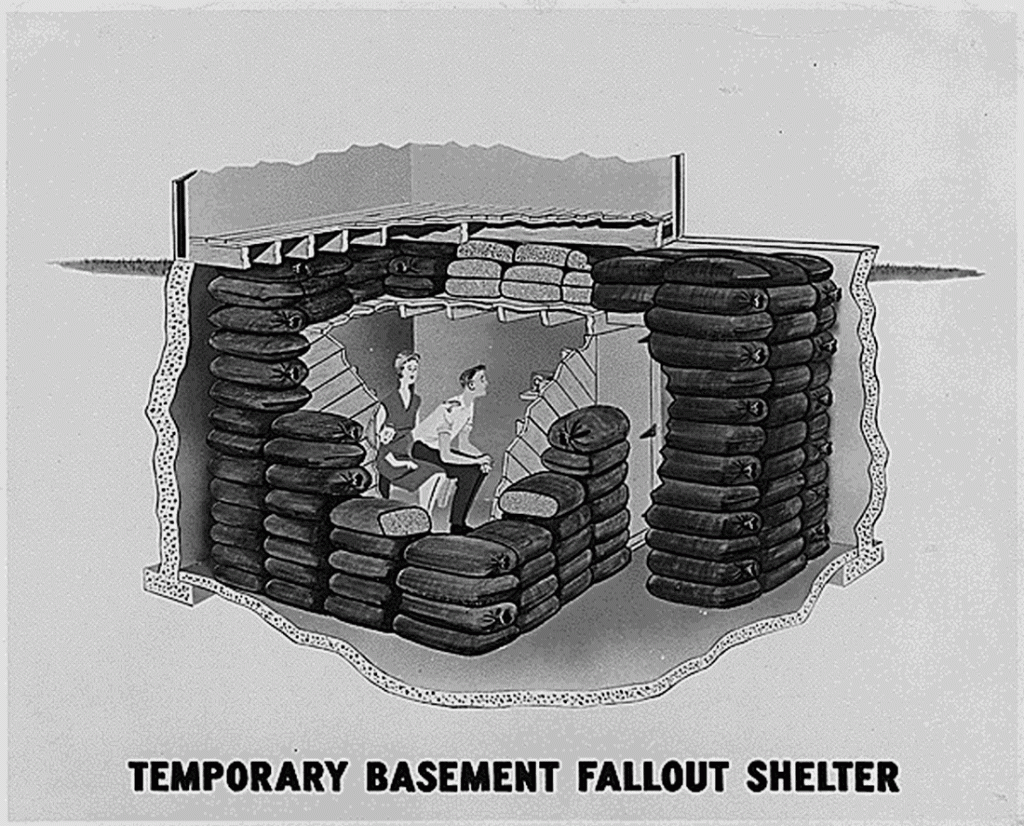It remains among the stranger articles ever published by a Cincinnati newspaper. On Christmas Eve 1950, the Enquirer announced that the new trend in home décor was the personal bomb shelter:
“Man, in the course of what he calls progress, is creating war monsters. To escape these monsters he is building a new sort of cave — the bomb shelter. No home may be termed completely ‘modern’ without one.”

Provided by United States National Archives https://catalog.archives.gov/id/542104 Use is unrestricted
Although the Enquirer reported a couple of examples, the home shelter was always more of an oddity than a trend. However, as the idea of “bomb shelters” gradually evolved into the concept of “fallout shelters,” Cincinnati planners looked around and asked themselves, “Where can we park several thousand citizens underground while radioactive debris settles gently on the nuclear wasteland outside?”
Someone suggested that Cincinnati’s empty subway tunnels might finally have found a purpose. As early as 1941, just after the United States entered World War II, some folks made a preliminary study of the subway as an air-raid shelter. Then, on 18 February 1951, the Enquirer reported that Cincinnati officials were again looking at the abandoned subway for civil defense purposes:
“In the event of an enemy attack, Cincinnatians may look with favor upon the abandoned $6 million rapid transit subway system as a handy bomb shelter. Possibilities of converting the underground tunnel into such a shelter are being studied.”
It was estimated at that time that the subway tunnels could accommodate 25,000 people during a nuclear attack. The idea sat on the shelf for the 1950s, but got legs again as the Cold War heated up in the early 1960s. By 13 January 1962, the Enquirer reported that the project was in motion:
“Cincinnati’s ‘hole in the ground,’ the unfinished rapid transit subway-and-surface system that never saw a rail, may really be an ace in the hole. For instance, the U.S. General Services Administration Friday will open bids in Chicago on proposals to convert the system’s underground Liberty Street station into a prototype community fallout shelter, one of the first in the nation.”
With bids accepted, construction began on 26 April 1962. Areas within the Liberty Street station were designated as first-aid rooms, kitchens, generators, decontamination showers and “dead body storage.” Wooden benches provided the only sleeping accommodations for the 500 planned occupants during their stay of up to two weeks.
Then, the headaches started.
Water was essential, not only for drinking, but for those decontamination showers. The original plan was to dig a well and install a pump in the subway tunnel. This proved impossible, according to the Enquirer [11 November 1963]:
“’It was the darndest thing we ever ran into,’ a GSA official pointed out. ‘You’d think there’d be plenty of water under Cincinnati — but we couldn’t find any. After we went down a couple hundred feet for water, we found a map which showed no water in the area. So we had to change our plans.’”

Photo provided by the United States National Archives https://catalog.archives.gov/id/542103 Use is unrestricted
Then the vandals attacked. Not all at once and not substantially destructive, but irritating enough to delay the project over repeated clean-ups. Most annoying was the inability to determine how the vandals were even getting into the shelter. If vandals have access, so would radioactive fallout. After one vandal smeared tar all over the shelter, the mystery deepened:
“’We don’t know how he got in,’ the Federal official said. ‘He sure didn’t have a key.’”
And that raised another issue. In the event of a nuclear attack, how would citizens get into the secure fallout shelter? Who had the key?
“The Enquirer sent a reporter to the shelter but he was unable to find any Federal, city, state or county official who would admit having a key to its big, steel doors.”
Eventually, workers found the vandals’ access point. Construction of the Millcreek Expressway, now known as I-75, had gouged a hole in an above-ground section of the subway tunnel, providing ready entry to the entire system.
The government, having expended a fair amount of cash on remodeling, professed some ambivalence about the accommodations beneath Central Parkway. An unnamed federal official [5 April 1963] told the Enquirer:
“It’s not a fallout shelter now. It’s an experiment. It won’t be a fallout shelter until the government puts up a sign and says it’s a fallout shelter . . . I think we gave this whole thing too much publicity in the first place – got everybody all stirred up.”
Despite all the snafus, the Hamilton County Civil Defense office hosted an open house for the subway fallout shelter on Christmas Eve 1963. The shelter was not entirely finished and it wouldn’t be officially recognized or stocked with emergency food supplies until security was tightened and random holes plugged. The local office was really proud of the project but the intended beneficiaries – Cincinnati residents – were not impressed. Almost no one showed up to tour the brand new $54,177 shelter.
Nor did anyone other than vandals pay much attention to the shelter for the next 28 years, when it was quietly decommissioned. Throughout the brief life of the unused shelter, one question kept popping up: How can people, in an emergency, get into a locked fallout shelter?
In the event of nuclear war, in other words, who had the key?
Photos of the derelict fallout shelter as it looks today can be found on Zach Fein’s blog.
This article was reposted with permission from Greg Hand, editor of Cincinnati Curiosities.





Facebook Comments